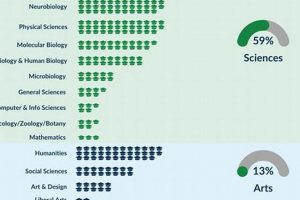High-quality diagnostic medical sonography programs in Houston prepare students for careers using ultrasound technology to create medical images for diagnostic purposes. These programs typically involve classroom instruction, laboratory experience, and clinical rotations in diverse healthcare settings. Graduates often pursue careers as cardiovascular technologists, vascular technologists, or diagnostic medical sonographers.
Skilled sonographers are vital to the healthcare system, providing crucial diagnostic information for a range of medical conditions. Houston, a major medical hub, offers a concentration of esteemed medical institutions and consequently a strong demand for qualified sonography professionals. The city’s rich medical landscape creates a dynamic learning environment for aspiring sonographers, providing access to cutting-edge technology and diverse patient populations. Historically, the evolution of ultrasound technology has significantly enhanced the capabilities of medical imaging, making sonography a cornerstone of modern medical diagnostics.
The following sections will delve into specific criteria for evaluating sonography programs, including accreditation, faculty expertise, clinical opportunities, and graduate outcomes, offering prospective students a roadmap for navigating the educational landscape in Houston and making informed decisions about their future careers.
Tips for Selecting a Sonography Program
Choosing the right educational path is crucial for a successful career in diagnostic medical sonography. Careful consideration of several factors can significantly impact future career prospects.
Tip 1: Seek Programmatic Accreditation: Accreditation by recognized bodies like the Commission on Accreditation of Allied Health Education Programs (CAAHEP) ensures adherence to high educational standards and may be required for professional certification and employment opportunities.
Tip 2: Evaluate Faculty Expertise: Experienced faculty with strong clinical backgrounds can provide valuable insights and mentorship, enriching the learning experience and preparing students for real-world practice.
Tip 3: Assess Clinical Opportunities: Robust clinical rotations in diverse healthcare settings provide essential hands-on experience and exposure to a wide range of pathologies and patient populations. Look for programs offering rotations in hospitals, clinics, and specialized imaging centers.
Tip 4: Research Graduate Outcomes: Investigate program graduate success rates, including job placement rates, certification exam pass rates, and alumni career trajectories. This information can provide valuable insights into the program’s effectiveness in preparing students for successful careers.
Tip 5: Consider Program Resources and Facilities: Access to state-of-the-art ultrasound equipment and technology is crucial for developing practical skills. Look for programs with modern laboratories and simulation facilities that replicate real-world clinical environments.
Tip 6: Explore Financial Aid Options: Understand the program’s tuition costs and available financial aid options, including scholarships, grants, and loan programs, to develop a sustainable financial plan.
By carefully considering these factors, prospective students can identify programs aligned with their career goals and maximize their potential for success in the field of diagnostic medical sonography. A well-chosen program lays a strong foundation for a rewarding and impactful career in healthcare.
This informed decision-making process equips prospective students to confidently embark on their educational journey and contribute meaningfully to the dynamic field of medical sonography.
1. Accreditation
Accreditation plays a pivotal role in defining high-quality sonography programs. In Houston’s competitive landscape of sonography education, accreditation serves as a critical marker of program excellence and significantly impacts the value of a sonography degree. Accreditation from recognized organizations, such as the Commission on Accreditation of Allied Health Education Programs (CAAHEP), signifies that a program meets stringent standards for curriculum, faculty qualifications, clinical resources, and student outcomes. This rigorous evaluation process ensures that graduates possess the knowledge, skills, and competencies necessary for successful entry into the profession. For example, graduates from CAAHEP-accredited programs often have a smoother pathway to obtaining professional certifications, like those offered by the American Registry for Diagnostic Medical Sonography (ARDMS), which are often preferred or required by employers.
The importance of accreditation extends beyond individual career prospects. Hospitals and healthcare facilities prioritize hiring graduates from accredited programs, recognizing the standardized education and training they receive. Accreditation contributes to the overall quality of healthcare services by ensuring a consistent supply of competent sonography professionals. This emphasis on accreditation ultimately benefits patients by providing access to skilled and qualified practitioners. Furthermore, some financial aid programs and scholarships may be exclusively available to students enrolled in accredited programs, highlighting the financial implications of accreditation.
In summary, accreditation functions as a cornerstone of quality assurance in sonography education. For prospective students in Houston, choosing an accredited program represents a significant investment in their future careers. This choice enhances employability, professional development opportunities, and access to financial resources. By prioritizing accredited programs, individuals contribute to upholding high standards within the sonography profession and ensuring the delivery of quality patient care within the broader healthcare system.
2. Faculty Expertise
Faculty expertise stands as a cornerstone of high-quality sonography education. In the competitive landscape of Houston’s sonography programs, the depth and breadth of faculty knowledge directly influence the caliber of graduates. A program’s faculty composition serves as a key differentiator, impacting students’ learning experiences and career trajectories.
- Specialized Instructors:
Instructors specializing in various sonography disciplines, such as obstetrics/gynecology, abdominal, cardiac, and vascular sonography, provide focused expertise within distinct areas of practice. This specialized instruction ensures students receive in-depth knowledge and practical training tailored to their specific career interests. For example, a program with a dedicated cardiac sonographer on faculty can offer students advanced insights into echocardiography techniques and interpretation, preparing them for specialized roles in cardiovascular settings.
- Clinical Experience:
Faculty with extensive clinical experience bridge the gap between theoretical knowledge and real-world practice. Instructors actively engaged in clinical work bring current industry practices, emerging technologies, and practical insights into the classroom. This real-world perspective enriches the learning experience and prepares students for the complexities of clinical environments. For instance, a faculty member actively practicing in a Level I trauma center can share valuable experience in managing complex trauma cases using sonography, providing students with a unique learning opportunity.
- Research and Innovation:
Faculty engaged in research and innovation contribute to the advancement of the sonography field. Their involvement in cutting-edge research exposes students to the latest technological advancements and emerging diagnostic techniques. This exposure prepares graduates for a rapidly evolving healthcare landscape and encourages a mindset of continuous learning and professional development. Faculty publications and presentations in peer-reviewed journals and conferences indicate a commitment to advancing the field and elevating the program’s academic reputation.
- Mentorship and Professional Development:
Experienced faculty serve as mentors, guiding students through their educational journey and fostering professional growth. Faculty mentorship provides valuable support in navigating career choices, pursuing professional certifications, and building professional networks. Strong mentorship programs contribute to higher student success rates and facilitate a smooth transition from education to practice. Faculty members advising students on professional organizations like the Society of Diagnostic Medical Sonography (SDMS) demonstrate a commitment to career development.
These combined facets of faculty expertise create a rich learning environment that equips graduates with the knowledge, skills, and professional connections necessary to excel in the field. In Houston’s dynamic healthcare market, top sonography schools prioritize attracting and retaining highly qualified faculty, recognizing their pivotal role in shaping successful graduates and contributing to the advancement of the sonography profession.
3. Clinical Placements
Clinical placements represent a crucial component of sonography education, bridging theoretical knowledge with practical, real-world experience. In Houston, the quality and diversity of clinical placements significantly differentiate top sonography programs, directly impacting graduates’ preparedness and career prospects. Robust clinical experiences within diverse healthcare settings are essential for developing competency and confidence in performing diagnostic ultrasound examinations.
- Diversity of Healthcare Settings:
Exposure to a variety of clinical environments, including large hospitals, small clinics, specialized imaging centers, and mobile ultrasound units, provides students with a broad understanding of sonography practice across different healthcare delivery models. Rotating through diverse settings allows students to adapt their skills to various patient populations, equipment, and procedural protocols. For example, experience in a high-volume urban hospital exposes students to a wider range of pathologies compared to a smaller, specialized clinic focusing on musculoskeletal injuries. Top programs in Houston leverage the city’s extensive healthcare network to offer diverse placement opportunities.
- Hands-on Scanning Experience:
Ample opportunities to perform ultrasound examinations on real patients under the supervision of experienced sonographers are fundamental. The quantity and quality of scanning time directly correlate with skill development and proficiency. Programs that prioritize hands-on learning, ensuring sufficient patient interaction and scan volume, better equip graduates for independent practice. A program offering extended clinical rotations in high-patient-volume settings allows for greater mastery of scanning techniques and image interpretation.
- Preceptor Mentorship:
Guidance from experienced clinical preceptors, often registered diagnostic medical sonographers (RDMS), provides invaluable insights into best practices, professional conduct, and patient interaction. Mentorship fosters professional growth and helps students integrate classroom knowledge into clinical practice. Effective preceptor programs offer individualized feedback and personalized guidance, enhancing the learning experience and promoting professional development. A program actively cultivating strong relationships with clinical preceptors demonstrates a commitment to student success.
- Advanced Technology Exposure:
Clinical placements in facilities equipped with state-of-the-art ultrasound technology provide students with experience using the latest imaging modalities and software. This exposure is essential for staying current with advancements in the field and ensures graduates are familiar with the tools and techniques used in modern healthcare settings. Experience with cutting-edge equipment, such as 3D/4D ultrasound and contrast-enhanced ultrasound, enhances marketability and prepares graduates for the demands of advanced practice.
The strength of clinical placements directly correlates with the quality of a sonography program. Top sonography schools in Houston recognize the critical importance of robust clinical experiences and actively cultivate partnerships with leading healthcare institutions to provide students with unparalleled learning opportunities. This focus on practical training ensures graduates possess the skills, experience, and confidence to excel in their careers and contribute meaningfully to patient care within the Houston healthcare community. Through these carefully curated clinical rotations, students gain invaluable practical experience, setting them apart in the competitive job market and positioning them for leadership roles within the field.
4. Cutting-Edge Technology
A strong correlation exists between access to cutting-edge technology and the quality of sonography education. Leading sonography schools in Houston prioritize investment in advanced ultrasound equipment and software, recognizing its crucial role in preparing students for the demands of modern healthcare. This access provides several key advantages, directly impacting student learning outcomes and career preparedness. Students gain proficiency in utilizing the latest imaging modalities, such as 3D/4D ultrasound, elastography, and contrast-enhanced ultrasound, expanding their skillset and enhancing their marketability to potential employers. For example, experience with high-frequency transducers allows for detailed visualization of superficial structures, while advanced software packages facilitate image analysis and interpretation, skills highly valued in specialized clinical settings like musculoskeletal or vascular sonography.
Furthermore, exposure to cutting-edge technology fosters adaptability and prepares graduates for the rapidly evolving technological landscape of healthcare. Familiarity with emerging technologies, like artificial intelligence (AI) assisted diagnostics and automated image analysis tools, positions graduates at the forefront of the profession. Practical experience with these advanced tools not only enhances diagnostic accuracy but also streamlines workflow efficiency, contributing to improved patient care and outcomes. For instance, AI-powered software can assist in identifying subtle anomalies and patterns within ultrasound images, aiding in early disease detection and improving diagnostic confidence. This technological proficiency attracts prospective students seeking advanced training and reinforces the reputation of Houston’s top sonography programs.
In summary, the integration of cutting-edge technology within sonography curricula represents a significant investment in student success. It equips graduates with the skills and knowledge to navigate the complexities of modern healthcare, contributing to improved patient care and diagnostic accuracy. Access to advanced technology serves as a key differentiator among sonography programs in Houston, attracting high-achieving students and positioning graduates for leadership roles within the field. This commitment to technological advancement reinforces the city’s reputation as a center for excellence in sonography education and practice.
5. Career Support
Robust career support services distinguish high-quality sonography programs. In the competitive Houston healthcare market, comprehensive career assistance significantly contributes to graduate success and aligns with the characteristics of top sonography schools. Effective career support encompasses a range of services designed to facilitate a smooth transition from education to employment. These services often include resume and cover letter writing assistance, interview preparation workshops, job search strategies, and networking opportunities with potential employers. For example, a program partnering with major Houston hospitals to host career fairs provides graduates direct access to hiring managers and valuable networking opportunities. This proactive approach connects students with potential employers and increases their chances of securing employment upon graduation.
Furthermore, strong career support extends beyond initial job placement. Top programs offer guidance on professional development, continuing education opportunities, and pathways to advanced certifications. This ongoing support fosters career advancement and ensures graduates remain competitive in the evolving healthcare landscape. For instance, a program offering workshops on advanced cardiac imaging techniques or assisting graduates with the Registered Diagnostic Cardiac Sonographer (RDCS) certification process demonstrates a commitment to long-term career growth. This commitment to continuing education and professional development enhances graduates’ marketability and positions them for leadership roles within the field. Mentorship programs connecting current students with alumni working in specialized areas also provide valuable insights into career paths and networking opportunities. This alumni network fosters a sense of community and provides ongoing support throughout graduates’ careers.
In summary, comprehensive career support services are integral to the success of sonography graduates in the Houston job market. Top sonography schools recognize this vital connection and invest in robust career services programs. These programs provide a crucial bridge between education and employment, equipping graduates with the tools and resources necessary to launch successful careers. This focus on career development not only benefits individual graduates but also contributes to the overall strength and quality of the sonography profession within the Houston healthcare community. By investing in career support, these institutions contribute to a well-prepared and highly skilled sonography workforce, ultimately benefiting patient care and advancing the field of diagnostic medical sonography.
Frequently Asked Questions
This section addresses common inquiries regarding sonography education in Houston, providing prospective students with essential information for informed decision-making.
Question 1: What distinguishes top sonography programs in Houston?
Key differentiators include programmatic accreditation, faculty expertise, clinical placement quality, access to cutting-edge technology, and comprehensive career support services. These factors contribute to a well-rounded education and successful career outcomes.
Question 2: How does one determine if a sonography program is accredited?
Accreditation status can be verified through recognized accrediting bodies, such as the Commission on Accreditation of Allied Health Education Programs (CAAHEP). Program websites and informational materials typically highlight accreditation status.
Question 3: What types of clinical experience are essential for sonography students?
Diverse clinical rotations in various healthcare settings, including hospitals, clinics, and specialized imaging centers, provide essential exposure to different patient populations, pathologies, and ultrasound equipment.
Question 4: How important is access to advanced ultrasound technology during training?
Exposure to state-of-the-art technology, including 3D/4D ultrasound and Doppler imaging, is crucial for developing proficiency with the tools used in modern healthcare and enhances graduates’ competitiveness in the job market.
Question 5: What career support services should prospective students look for?
Comprehensive career services should include resume and cover letter assistance, interview preparation, job search guidance, networking opportunities, and continuing education support.
Question 6: How does one research the reputation and success rates of sonography programs?
Program websites, professional organizations, and alumni networks offer valuable insights into graduate outcomes, including job placement rates and certification exam pass rates. Independent online resources may also provide program reviews and rankings.
Careful consideration of these factors empowers prospective students to select the best sonography program aligned with individual career aspirations and goals.
For further information and program-specific details, prospective students should consult individual program websites and contact admissions offices directly.
Conclusion
Superior sonography programs in Houston distinguish themselves through key characteristics: programmatic accreditation, experienced faculty, diverse clinical placements, access to cutting-edge technology, and robust career support. These elements collectively contribute to a comprehensive educational experience, preparing graduates for successful and rewarding careers in diagnostic medical sonography. The Houston healthcare landscape, characterized by a concentration of leading medical institutions and a high demand for skilled sonographers, offers a dynamic and competitive environment. Success within this market requires rigorous training and a commitment to professional development.
Choosing a high-quality sonography program represents a pivotal investment in one’s future. Thorough research, careful consideration of program characteristics, and alignment with individual career goals are essential for making informed decisions. This deliberate approach empowers aspiring sonographers to embark on a fulfilling career path, contributing meaningfully to patient care and the advancement of medical imaging within the vibrant Houston healthcare community.







